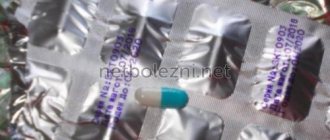Write a review
Reviews: 5
Manufacturers: Kievmedpreparat
Active ingredients
- Interferon alpha-2b human recombinant
Disease class
- Not indicated. See instructions
Clinical and pharmacological group
- Immunostimulating drugs
Pharmacological action
- Immunostimulating
Pharmacological group
- Immunomodulators
Pharmacological properties of the drug Laferobion
Immunological and biological properties Laferobion contains recombinant human interferon, which is completely identical to interferon alpha-2b, which is synthesized by donor blood leukocytes in response to the action of the interferonogen virus. Human recombinant interferon alpha-2b, like natural leukocyte interferon, has three main types of biological activity: immunomodulatory, antiviral and antitumor. Non-toxic. After injections of Laferobion, the interferon included in its composition binds to specific membrane receptors of the cell membrane and induces a complex of intracellular reactions: protein synthesis, suppression of cell proliferation, immunomodulatory activity, such as the phagocytic activity of macrophages and the specific activity of lymphocytes to target cells, and inhibits viral replication in virus-infected cells. The maximum concentration in blood plasma after intramuscular or subcutaneous administration is within the range of 18–116 IU/ml in the range of 3–12 hours after administration. The half-life after intramuscular or subcutaneous administration is 2–3 hours. After intravenous administration, the maximum concentration is reached after 30 minutes, the half-life is about 2 hours.
pharmachologic effect
The active ingredient Laferobion has antiviral, antitumor and immunomodulatory effects, while it is recombinant human interferon and has no toxic effects.
Laferobion reaches its maximum concentration when administered subcutaneously or intramuscularly after 4-10 hours.
Laferobion increases immunomodulatory activity, suppresses the proliferation and growth of viruses in infected cells. According to reviews, Laferobion is effective and safe in the treatment of infants from various infectious diseases.
Indications for use of the drug Laferobion
Laferobion is used in complex therapy of adults and children for:
- acute and chronic viral hepatitis B (moderate and severe forms);
- acute viral, bacterial and mixed infections, including in newborns;
- acute and chronic septic diseases of viral and bacterial nature, including disseminated forms of acute and chronic sepsis;
- herpetic infections of various localizations: herpes zoster, multiple skin herpetic rashes; genital herpetic infection; herpetic keratoconjunctivitis and keratouveitis, etc.;
- laryngeal papillomatosis;
- multiple sclerosis;
- malignant tumors;
- melanoma of the skin and eyes;
- cancer of the kidney, bladder, ovary, breast;
- Kaposi's sarcoma;
- multiple myeloma.
Use of the drug Laferobion
Lyophilisate for nasal solution For treatment purposes, Laferobion is used at an early stage of the disease when the first clinical symptoms appear. The earlier it was used, the higher the effectiveness of the drug. In the treatment of influenza and other acute respiratory viral infections and viral-bacterial infections, the drug is used by spraying, instillation or inhalation. When sprayed or instilled, a drug with an activity of 50,000–100,000 IU is administered 0.25 ml (5 drops) into each nasal passage after 1–2 hours, but not less than 6 times a day for 2–3 days. The most effective is inhalation. Ultrasonic inhalers are recommended for this purpose. For one administration, use 3 bottles of the drug, the contents of which are dissolved in 5 ml of water. By inhalation, the drug is administered through the mouth and nose 2 times a day. When treating newborns, a solution of the drug Laferobion with an activity of 50,000 IU is instilled in 2-3 drops into each nasal passage 4-6 times a day for 3-5 days. It is recommended to alternately introduce turundas moistened with a solution of the drug into the nasal passages for 10–15 minutes. For the purpose of prevention, the administration of Laferobion should be started in case of an immediate threat of infection and continued as long as there is a risk of infection. For the prevention of influenza and other acute respiratory viral infections and viral-bacterial infections, the drug Laferobion is used by spraying or instilling its aqueous solution with an activity of 50,000–100,000 IU per 1 ml. To obtain an aqueous solution, open the bottle with the drug immediately before use and add sterile distilled or boiled water, cooled to room temperature. To obtain a solution of a drug with an activity of 50,000 IU in 1 ml, add 2 ml of water to the bottle, and with an activity of 100,000 IU in 1 ml - 1 ml of water. Then the bottle is gently shaken until its contents are completely dissolved. Spraying of the drug can be carried out using sprayers of any system. 0.25 ml of the solution must be administered into each nasal passage 2 times a day with an interval of at least 6 hours. When instilled, the drug is administered 5 drops into each nasal passage 2 times a day with an interval of at least 6 hours. Lyophilisate for p -ra for injection is used intramuscularly or subcutaneously, dissolving the contents of the ampoule or bottle in 1 ml of water for injection immediately before use. Viral diseases. For acute hepatitis B (mild, moderate and severe forms), Laferobion is administered at a dose of 1 million IU 2 times a day for 5–6 days, then the dose is reduced to 1 million IU per day and administered for another 5 days. If necessary (after control biochemical blood tests to assess the functional state of the liver), treatment can be continued for another 2 weeks, during which the drug is administered at a dose of 1 million IU 2 times a week. Laferobion is most effective at the beginning of the icteric period up to 5 days of jaundice; in the long term, the administration of the drug is less effective. Laferobion is ineffective in the initial period of hepatic coma and in the cholestatic variant of the disease. For chronic active hepatitis B, Laferobion is prescribed at a dose of 3 million–6 million IU 3 times a week for 24 weeks. If after administration of the drug for 12 weeks there is no clinical, biochemical improvement and/or disappearance of HbeAg, treatment with Laferobion is discontinued. For chronic hepatitis C, Laferobion is prescribed at a dose of 3 million IU 3 times a week for 24 weeks. If after administration of the drug for 4 weeks a 50% decrease in ALT activity in the blood plasma is not detected, the dose of the drug is increased to 6 million IU 3 times a week. Treatment with Laferobion is completed if, after 12 weeks of use of the drug, no clinical and biochemical improvement is noted. For tick-borne encephalitis, Laferobion is effective for meningeal forms of tick-borne encephalitis, the causative agent of which is widespread. Laferobion is administered at a dose of 1 million–3 million IU 2 times a day for 10 days. Then maintenance treatment is prescribed - 5 times 1 million–3 million IU every 2 days. Oncological diseases. The general principle of using interferon in cancer is to prescribe the maximum dose that the patient can tolerate over a sufficiently long period (months, years). Since interferon alpha has a cytostatic effect, maintenance treatment with Laferobion should be continued after achieving an objective effect - hematological remission, regression of the solid tumor focus or stabilization of the disease. For hairy cell leukemia, Laferobion is administered 3 million IU daily. After achieving hematological remission, they switch to maintenance therapy of 3 million IU 3 times a week. For chronic myeloid leukemia, Laferobion is used at a dose of 9 million IU daily. After achieving hematological remission, maintenance therapy is prescribed at a dose of 9 million IU 3 times a week. For renal cell carcinoma, Laferobion is administered at a dose of 18 million IU 3 times a week. The objective effect (complete or partial regression of metastases) appears after 8–12 weeks of treatment with Laferobion or later. When the therapeutic effect of stabilization of the disease is achieved, maintenance treatment is continued at 18 million IU 3 times a week. For Kaposi's sarcoma on the background of AIDS, Laferobion is administered every day at 36 million IU. The drug is used for a long time, except in cases of rapid progression of the disease or severe intolerance. After the effect appears, maintenance therapy is prescribed at 18 million IU 3 times a week. For cutaneous T-cell lymphoma (mycosis fungoides and Sézary syndrome), Laferobion is prescribed at a dose of 18 million IU daily. For malignant melanoma, Laferobion is administered 18 million IU daily. After achieving an objective effect (complete or partial regression of metastases), maintenance therapy is prescribed at a dose of 18 million IU 3 times a week. To prolong remission and increase the life expectancy of patients after surgical removal of the primary tumor of stage I–II melanoma or regional lymph nodes with metastases, auxiliary treatment with Laferobion is used at a dose of 18,000,000 IU 3 times a week.
Side effects of the drug Laferobion
Possible: flu-like symptoms, especially fever, headache, chills, tremor, myalgia, fatigue, asthenia, arthralgia, dizziness, neck and back pain, eye pain, dry mouth. The body as a whole . Allergic reactions, cachexia, dehydration, hypercalcemia, hyperglycemia, hypothermia, lymphadenitis, lymphadenopathy, periorbital edema, deterioration of peripheral circulation, peripheral edema, superficial phlebitis, genital edema, thirst, weakness, weight gain. From the hematopoietic system . Hypochromic and hemolytic anemia, granulocytopenia, leukopenia, lymphocytosis, neutropenia, thrombocytopenia, thrombocytopenic purpura. From the cardiovascular system. Angina pectoris, arrhythmia, extrasystole, ventricular fibrillation, bradycardia, tachycardia, cardiomegaly, cardiopathy, arterial hypotension, pulmonary embolism, Raynaud's syndrome, thrombosis, varicose veins. From the endocrine system. Gynecomastia, hyperglycemia, hyperthyroidism, hypertriglyceridemia, hypothyroidism, virilism. From the gastrointestinal tract. Diarrhea, anorexia, nausea, taste disturbance, stomach pain, atony, dyspepsia, vomiting, gingivitis. From the hepatobiliary system. Increased levels of liver transaminases, LDH, hepatitis, bilirubinemia, pain in the right hypochondrium, very rarely - hepatic encephalopathy and death. From the musculoskeletal system. arthritis, arthrosis, bone pain, hyporeflexia, leg cramps, muscle weakness and atrophy, periarteritis nodosa, tendinitis, rheumatoid arthritis, spondylitis. From the nervous system and mental disorders . Depression, paresthesia, impaired concentration, amnesia, hypoesthesia, sleep disturbance, impaired coordination of movements, impaired thinking, aggressive reactions, agitation, alcohol intolerance, apathy, aphasia, ataxia, coma, convulsions, delirium, dysphonia, emotional lability, extrapyramidal disorders, hearing impairment, hyperesthesia, tremor, hyper- and hypokinesia, migraine, neuralgia, neuritis, neuropathy, neurosis, polyneuropathy, speech impairment, dizziness, suicidal tendencies. From the reproductive system. Amenorrhea, dysmenorrhea, impotence, sexual dysfunction, urinary dysfunction, vaginal dryness. From the respiratory system. Dyspnea, nonproductive cough, sinusitis, rhinitis. From the skin and its derivatives . Dermatitis, alopecia, rash, dry skin, itching.
Side effects
When using Laferobion, the side effects that occur usually disappear after the end of treatment. According to reviews, Laferobion can cause:
- Chills;
- Sleep disturbance;
- Fatigue;
- Sweating;
- Increased body temperature;
- Myalgia;
- Headache;
- Arthralgia;
- Lethargy.
To reduce these symptoms when using Laferobion, the use of paracetamol is recommended.
With long-term therapy with Laferobion according to the instructions, the following may occur:
- Arthralgia;
- Dizziness;
- Increased excitability or drowsiness;
- Alopecia;
- Parasthesia;
- Tachycardia;
- Ataxia;
- Tides;
- Cough;
- Leuko- and thrombocytopenia;
- Vomit;
- Skin rash or itching;
- Herpetic lesions.
Much less often, according to reviews of Laferobion, anxiety and depression, nosebleeds and confusion occur.
Special instructions for the use of the drug Laferobion
The solution of the drug Laferobion must be used for one day, provided it is stored at a temperature of 2–8 °C. Use during pregnancy and lactation. The effect of the drug has not been studied during pregnancy and lactation. Children. Laferobion in the form of a lyophilisate for nasal solution is used under medical supervision. information regarding the use of Laferobion in the form of a lyophilisate for injection solution in pediatric practice, therefore the administration of this drug is contraindicated for children under the age of 18 years. The ability to influence reaction speed when driving vehicles or working with other mechanisms. We haven't studied it. It is necessary to warn the patient to avoid drinking alcohol during treatment with the drug.
Contraindications
According to the instructions, Laferobion is contraindicated for:
- Intolerance to the active substance - interferon, as well as other components of the drug,
- Severe kidney and liver diseases;
- Severe cardiovascular diseases;
- Inhibition of the myeloid lineage of hematopoiesis;
- Thyroid diseases;
- Epilepsy and other diseases of the central nervous system;
Laferobion is contraindicated for use during pregnancy and lactation due to the lack of necessary studies.


